The Maldives is often seen as a destination for luxury resorts, but there’s another side to this tropical paradise. Island hopping in the Maldives offers an affordable and authentic way to explore its beauty. If you’re looking for a mix of adventure, local culture, and stunning beaches, Rasdhoo and Mathiveri should be on your itinerary.
Affiliate disclosure: This article contains affiliate links. If you choose to make a purchase through them, we may earn a small commission at no additional cost to you. These commissions help us continue creating helpful travel guides, tips, and inspiration. Thank you for your support!
Why Choose Rasdhoo & Mathiveri for Island Hopping?
One of the best things about visiting Rasdhoo and Mathiveri is their easy accessibility from Malé. Unlike remote islands requiring costly seaplane transfers, these two gems are just 1 to 1.5 hours away by speedboat. This makes them a budget-friendly and time-saving choice.
These local islands offer a unique contrast. Rasdhoo is a diver’s paradise, known for its world-class snorkeling and vibrant marine life. Meanwhile, Mathiveri is a peaceful retreat with pristine beaches and a relaxed vibe. In this guide, we’ll cover top activities, travel tips, accommodations, and insider advice to help you plan your trip.

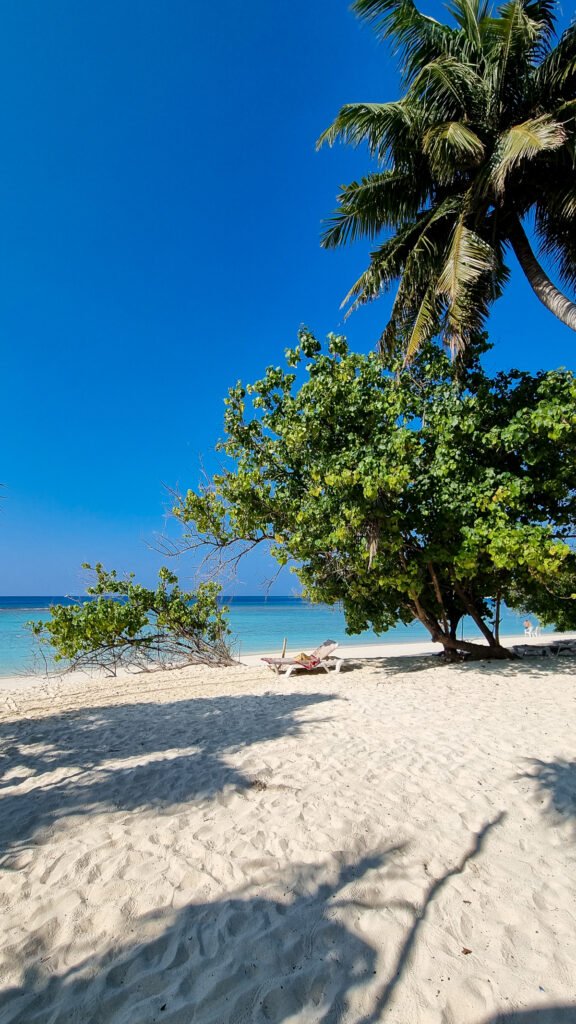
How To Navigate Around The Maldives
There are three ways to travel between islands in the Maldives: public ferries, scheduled speedboats, and seaplanes. Public ferries generally run only once a day—they are affordable but slow. In contrast, speedboats are more expensive but significantly faster. Seaplanes are the most costly option and are mainly used to reach remote resort islands.
For our island hopping in the Maldives, we took a mix of one public ferry and two speedboats. Upon arriving in Malé, we took a scheduled speedboat to Rasdhoo, which our guesthouse had already booked for us. Speedboats must be booked in advance (your guesthouse can arrange this for you), whereas, for public ferries, you can simply show up at the harbor.
After staying in Rasdhoo, we took the public ferry to Mathiveri at 1 PM for just $2—a two-hour journey. For our return to Malé, our guesthouse booked us a speedboat from Mathiveri.
To check the latest speedboat and ferry schedules, visit Halamaldif.
Malé vs. Hulhumalé: What’s the Difference?
Many travelers visiting the Maldives for the first time don’t realize that Malé and Hulhumalé are two different places—and this can be confusing when booking transportation.
Hulhumalé is the airport island. Malé is a separate island, a short ferry ride away from Hulhumalé.
When you land in the Maldives, you’re actually arriving on Hulhumalé, not Malé. The speedboat terminal for island transfers is just outside the airport, making it incredibly convenient to head straight to resorts or local islands.
- Key Fact: If your guesthouse or resort tells you to take a speedboat from “Malé,” they often mean the jetty outside the airport on Hulhumalé.
- No need to go into Malé unless you have a specific reason, like sightseeing or an overnight stay.
Difference Between Local Island and Resort Island
Local islands and resort islands in the Maldives offer completely different experiences. If you’re planning island hopping, local islands would be for you!
Resort islands are private luxury escapes with overwater villas, fine dining, and unlimited alcohol. They offer seclusion and world-class service but at a much higher cost. Most resorts require costly transfers by seaplane or private speedboat.
Local islands, on the other hand, are home to Maldivians and offer a budget-friendly, cultural experience. You’ll find affordable guesthouses, local restaurants, and public ferries or speedboats instead of expensive seaplanes. However, alcohol is banned, and bikinis are only allowed on designated beaches.
Island Hopping in the Maldives: What Makes Rasdhoo Special?
For our trip to the Maldives, we knew we wanted to explore its incredible underwater world. After some research, we discovered that Rasdhoo is one of the best islands in the world for scuba diving—and it did not disappoint!
We spent a few days in Rasdhoo diving with Family Divers and stayed at their guesthouse, Rasdhoo Vibes. They took care of everything for us, from booking our transfer to arranging our stay, and were always available to answer any questions. Our dives with them were unforgettable—we swam alongside sharks, turtles, and even manta rays! If you’re a diver, Rasdhoo should be at the top of your list.
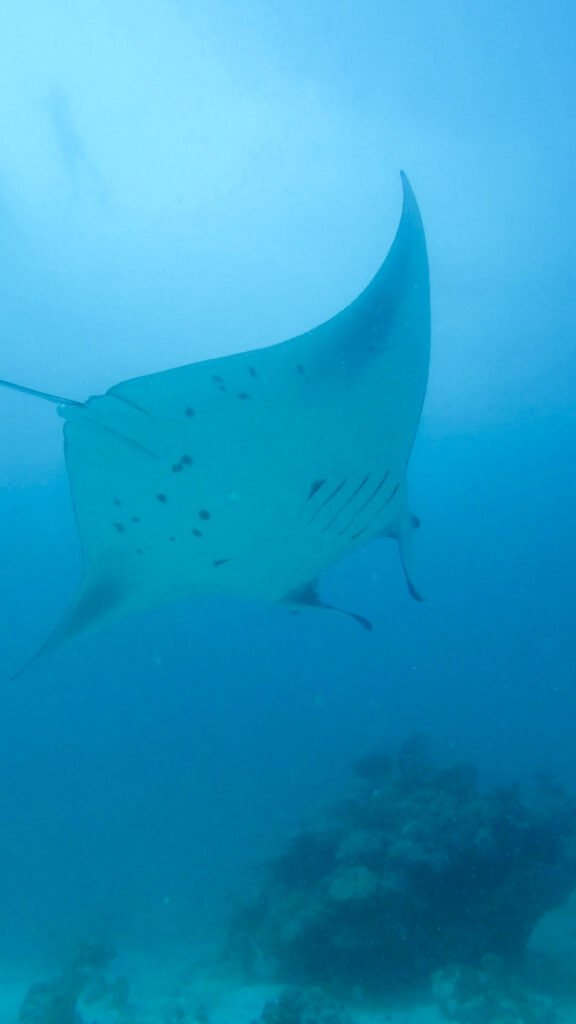

Things to do in Rasdhoo
That said, Rasdhoo is a must-visit for anyone planning island hopping in the Maldives, even if you don’t dive. The island has a beautiful Bikini Beach, where tourists can sunbathe freely. The soft sand and crystal-clear water make it the perfect spot to relax. We found the beach clean and never overcrowded, with free sunbeds and showers available.
Snorkeling along the reef was another highlight—we spotted colorful fish and even graceful eagle rays just off the shore. One of the best things about island hopping in the Maldives is discovering world-class diving and snorkeling spots, and Rasdhoo is a prime location for that.
Beyond the beach and the ocean, Rasdhoo has a friendly, laid-back local vibe. Small cafés and souvenir shops offer a glimpse into Maldivian culture, and while there are only a few restaurants on the island, we especially enjoyed Lemon Drop. You can also rent kayaks or book snorkeling tours to the nearby sandbank, though we didn’t get the chance to try.
Rasdhoo felt so authentic and welcoming—we honestly wished we could have stayed longer. But it was time for us to move on.
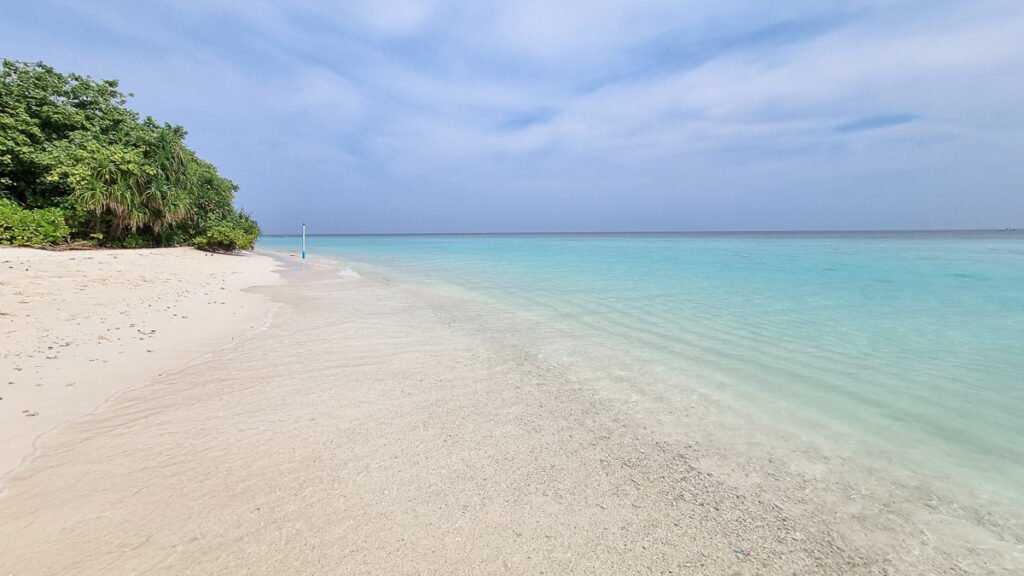

Are you enjoying this blog post? Follow us to see the latest updates
Why Mathiveri is a Must-Visit in the Maldives
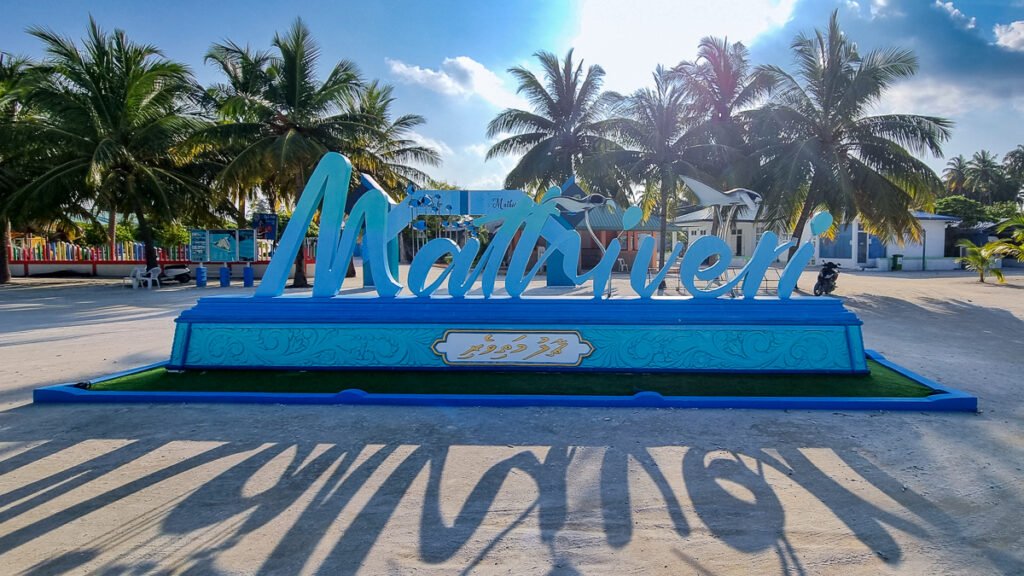
Leaving Rasdhoo wasn’t easy, but we were excited for our next stop: Mathiveri. We arrived at Rasdhoo harbor and boarded the 1 PM public ferry, which took two hours to reach Mathiveri. This small local island quickly became one of the highlights of our island-hopping adventure in the Maldives.
We stayed at Mystic Mathiveri, a simple yet comfortable guesthouse surrounded by lush tropical greenery, complete with a dedicated yoga section. The staff was incredibly welcoming and always made sure we had everything we needed, making our stay even more enjoyable.
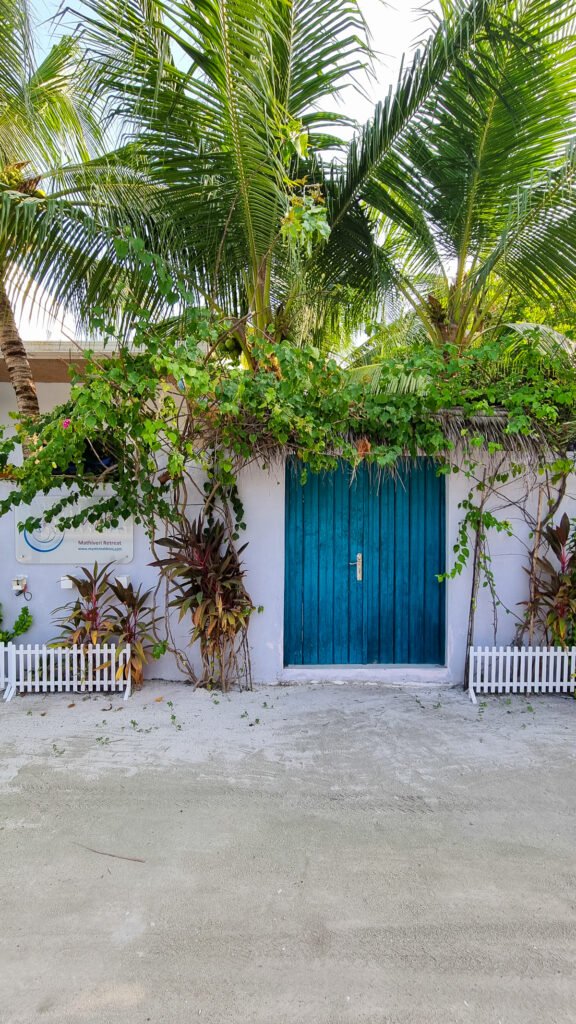

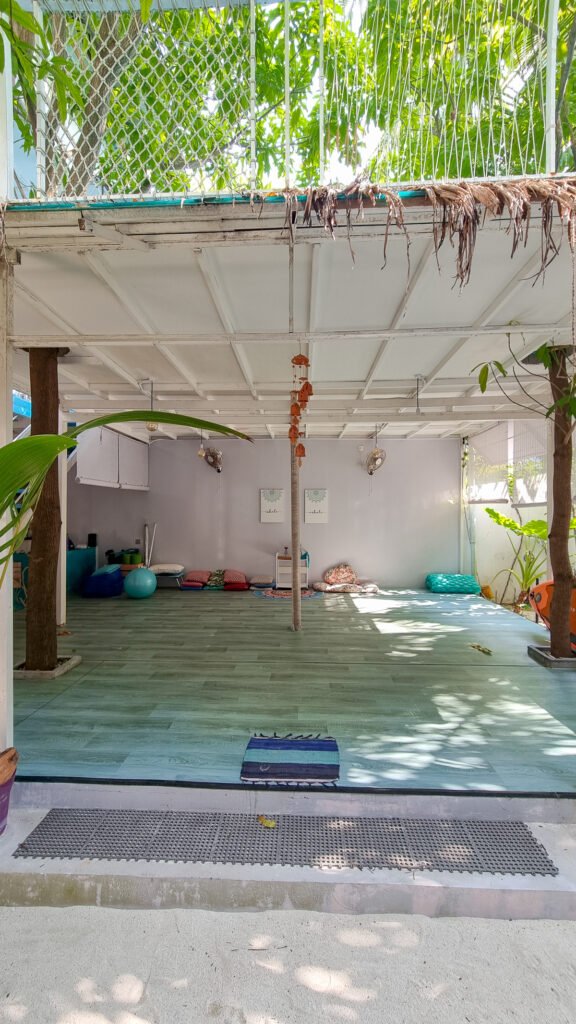
Mathiveri has a relaxed, peaceful atmosphere, perfect for slowing down and enjoying island life. The Bikini Beach is stunning, with crystal-clear waters that make it feel like a private paradise. While the sand is soft, there are some corals in the shallow waters, so wearing sandals or water shoes is a good idea.
What truly makes Mathiveri special is its nearby sandbank, Mathiveri Finolhu. Located just in front of Bikini Beach, it’s easily accessible by a short swim or boat ride. We spent hours here, relaxing and swimming in the warm, shallow waters—it felt like a little piece of paradise.
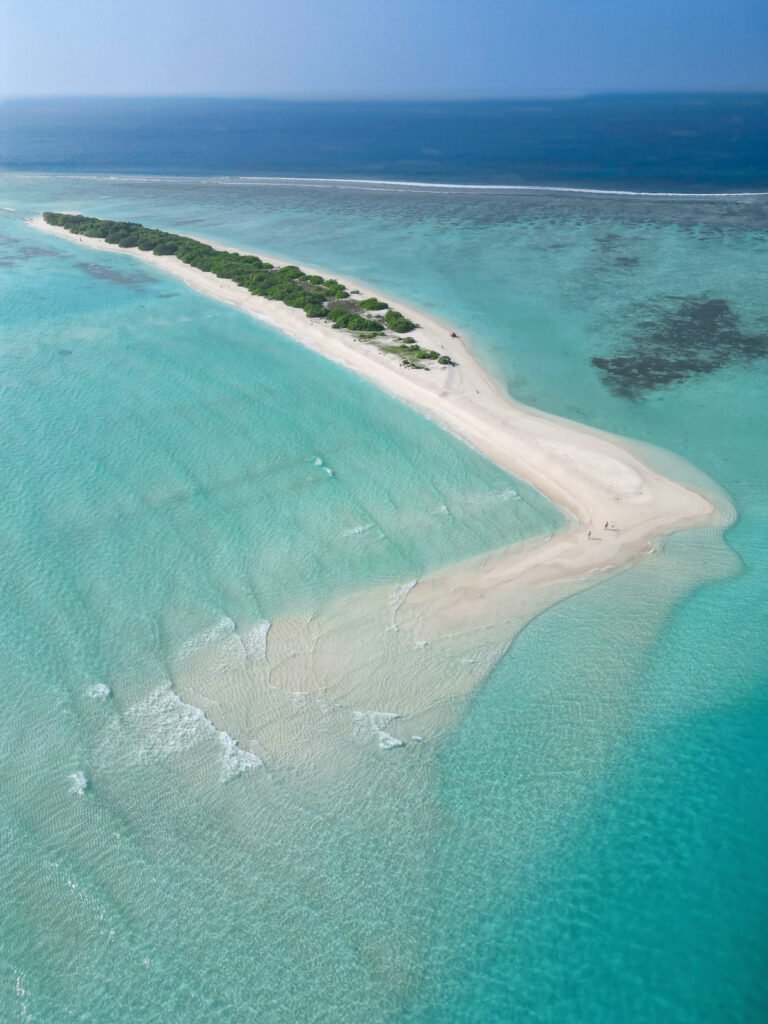
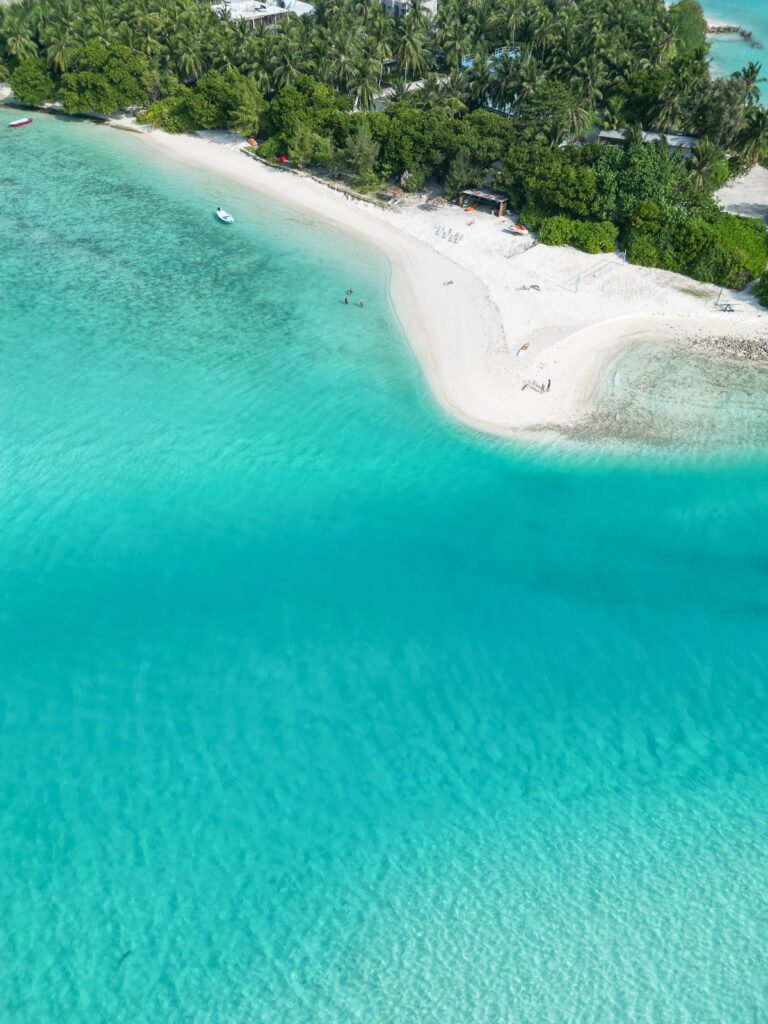

Things to do in Mathiveri
For activities, the island has only one tour operator, Let’s Go Excursions. The most popular tours are snorkeling with sharks and manta rays, as well as snorkeling at the nearby shipwreck. We couldn’t resist and added two incredible dives to our trip, making our experience even more unforgettable.
What we loved most about Mathiveri was its calm, authentic local vibe. It’s much less touristy than other islands, which makes it feel more genuine and untouched. There are only a few restaurants, but they serve delicious fresh seafood and Maldivian dishes. The island is small, so everything is within walking distance, and the locals were incredibly friendly.
If you want to experience the quieter side of Maldives island hopping, Mathiveri is the perfect escape!


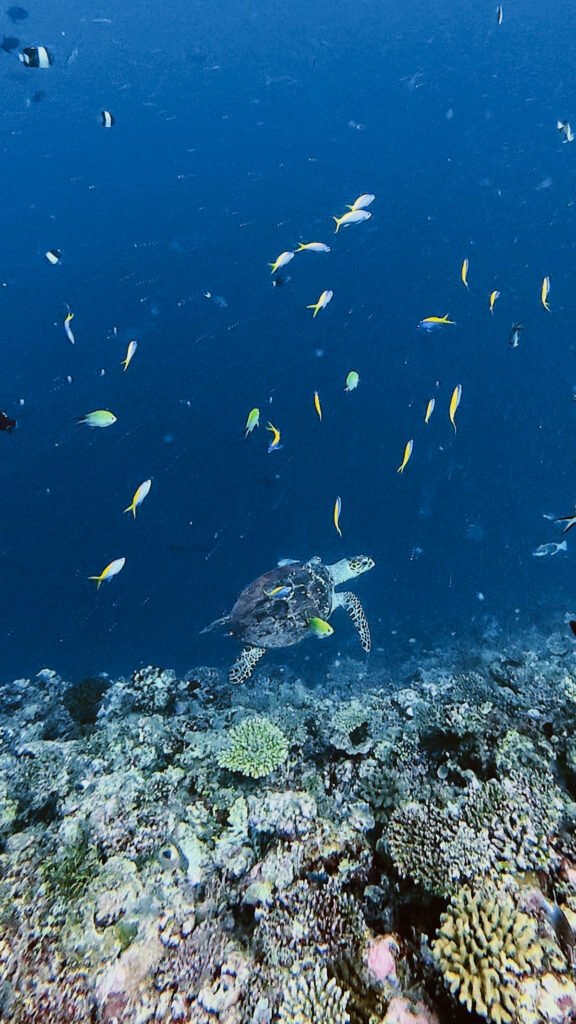
A Short Stay in Malé Before Heading Home
On our last day, we took the speedboat from Mathiveri to Malé, where we stayed overnight since we had an early flight the next morning. We stayed at Zan Lodge, a simple but convenient place for a short stay near the airport jetty.
After the tranquility of the islands, arriving in bustling Malé felt like a bit of a shock—it’s crowded, noisy, and busy, so we didn’t explore much. Instead, we just went out for dinner and kept it low-key.
The next morning, we took the public ferry to Hulhumalé for just $1, a quick and easy ride.
While Malé wasn’t our favorite stop, it was a practical choice before catching our flight. In our opinion staying overnight in Malé or Hulhumalé is essential, considering that speedboats can experience significant delays (both on our way there and back, they departed an hour late). We strongly advise against leaving the islands on the same day as your flight and recommend spending the night in Malé instead.
Tips for Island Hopping in the Maldives
Here are some practical tips to make your Maldives adventure smoother:
Getting a SIM Card in the Maldives
Staying connected in the Maldives is easy and affordable. At Velana International Airport, you’ll find booths for Dhiraagu and Ooredoo, the two main telecom providers. For convenience, we downloaded an eSIM before departure and activated it upon arrival. The process was quick, and having mobile data was incredibly useful for checking ferry schedules, maps, and staying in touch with guesthouses.
Money: Cash or Card?
The local currency is the Maldivian Rufiyaa (MVR), but US dollars and Euros are widely accepted on local islands. Most businesses accept USD cash or card payments, though using a card often comes with a commission fee.
ATMs are available in Malé, Rasdhoo, and Mathiveri, but they charge high withdrawal fees, so it’s best to bring some cash and exchange a small amount into MVR if needed. Keep in mind that MVR cannot be exchanged back to foreign currency, so try to spend any leftover rufiyaa before leaving.
How to Stay on a Budget
The Maldives has a reputation for being expensive, but island hopping on local islands is much more affordable than staying at luxury resorts. Here are some ways to save money:
- Stay in guesthouses instead of resorts – you’ll pay around $40–$80 per night instead of hundreds.
- Use public ferries ($2–$5 per ride) or shared speedboats instead of private transfers.
- Eat at local restaurants where meals cost $5–$10 instead of resort prices.
- Book activities directly with local dive centers or guesthouses instead of through third-party tour agencies.
Respecting Local Culture
The Maldives is a Muslim country, so local islands follow Islamic customs. This means:
- No alcohol on local islands (it’s only available at resorts).
- Dress modestly when walking around town—bikinis are only allowed at designated Bikini Beaches.
- Friday is a prayer day, so ferry schedules may be limited, and some businesses may open late.
Final Thoughts on Island Hopping in the Maldives
Our island-hopping trip in the Maldives was an unforgettable experience. From the incredible diving in Rasdhoo to the relaxed vibe of Mathiveri, each island had something unique to offer. We loved the mix of adventure and tranquility, and staying on local islands allowed us to experience the Maldives in an authentic and budget-friendly way.
While getting around takes some planning, using public ferries and shared speedboats made it easy and affordable. Staying connected with a local eSIM, carrying some cash in USD and MVR, and respecting local customs all helped make our trip smooth and enjoyable.
If you’re looking for a Maldives experience beyond luxury resorts, island hopping is the way to go. The stunning beaches, warm hospitality, and incredible marine life make it a trip we’ll never forget—and we can’t wait to go back!
Travel prepared.
Get your insurance today.
